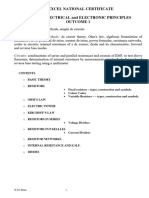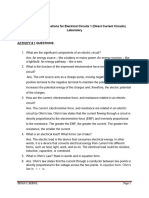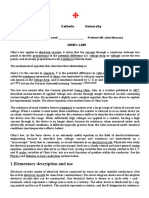Physics Laboratory Report Verifying Ohms Law: Institute of Health Scinces
Physics Laboratory Report Verifying Ohms Law: Institute of Health Scinces
Uploaded by
Mompati LetsweletseCopyright:
Available Formats
Physics Laboratory Report Verifying Ohms Law: Institute of Health Scinces
Physics Laboratory Report Verifying Ohms Law: Institute of Health Scinces
Uploaded by
Mompati LetsweletseOriginal Description:
Original Title
Copyright
Available Formats
Share this document
Did you find this document useful?
Is this content inappropriate?
Copyright:
Available Formats
Physics Laboratory Report Verifying Ohms Law: Institute of Health Scinces
Physics Laboratory Report Verifying Ohms Law: Institute of Health Scinces
Uploaded by
Mompati LetsweletseCopyright:
Available Formats
INSTITUTE OF HEALTH SCINCES
PHYSICS LABORATORY REPORT
VERIFYING OHMS LAW
MOMPATI LETSWELETSE
10/29/2014
MOMPATI LETSWELETSE ID: 3122
Date: 12-10-2014
TITLE: Ohm s Law and Resistor Circuits
AIM: To verify Ohms s law
APPARATUS
Rheostat(variable resistor)
Voltmeter
Ammeter
Crocodile clips
Connecting wire
Circuit board
THEORY
In the Botswana, most of us use electricity every day. That electricity is handled in circuits: a
closed loop of conductors travelling from power plants to neighborhoods to households and
back again. That closed loop, with all of its many parts, forms one huge electrical circuit.
Electricity is very useful when it comes to medical field as it used in various important aspects
which include saving the life of an individual using life saving machine, used to make an artificial
heart in case of heart failure, diagnose certain disease used in telemedicine among others
One of the fundamental laws describing how electrical circuits behave is Ohms law. According
to Ohms law, there is a linear relationship between the voltage drop across a circuit element
and the current flowing through it. Therefore the resistance R is viewed as a constant
independent of the voltage and the current. In equation form, Ohms law is:
V = IR.
V is the voltage applied across the circuit in volts (V), I is the current flowing through the circuit
in units of amperes (A), and R is the resistance of the circuit with units of ohms (). The above
equation implies that, for a resistor with constant resistance, the current flowing through it is
proportional to the voltage across it. If the voltage is held constant, then the current is inversely
proportional to the resistance. If the voltage polarity is reversed (that is, if the applied voltage is
negative instead of positive), the same current flows but in the opposite direction.
If Ohms law is valid, it can be used to define resistance as:
R=
Where R is a constant, independent of V and I. It is important to understand what is meant by
these quantities. The current (I) is a measure of how many electrons are flowing past a given
point during a set amount of time. The current flows because of the electric potential (V ),
1
MOMPATI LETSWELETSE ID: 3122
sometimes referred to as the voltage, applied to a circuit. In much the same way that a
gravitational potential will cause mass to move, the electric potential will cause electrons to
move. If one point of the circuit has a high electric potential, it means that it has a net positive
charge and another point of the circuit with a low potential will have a net negative charge.
Electrons in a wire will flow from low electric potential with its net negative charge to high
electric potential with its net positive charge because unlike charges attract and like charges
repel. As these electrons flow through the wire, they are scattered by atoms in the wire. The
resistance of the circuit is a measure of how difficult it is for the electrons to flow in the
presence of such scattering. Materials that have a low resistance are called conductors and
materials that have a very high resistance are called insulators. Some materials have a
moderate resistance and still allow some current to flow. In a nutshell the electric potential
causes the current to flow and the resistance impedes that flow.
PROCUDURE
Figure 1: Experimental circuit
Power supply on the left (from the circuit) was set at 3VDC.The 340 rheostat was connected
as the voltage divider. By moving the rheostat wiper, the voltage across r was varied from 0 to
3V.
The voltmeter was connected across the ends of a resistor while the ammeter A connected the
rheostat to the resistor and was said to be in series with the resistor. The current I through R
was measured for at least 5 voltages across R and 1 and 3 volts
MOMPATI LETSWELETSE ID: 3122
RESULT AND ANALYSIS
THE TABLE BELOW SHOWS THE CURRENT VALUES WITH THEIR CORRESPONDING
VOLTAGE VALUES OBTAINED IN AN EXPERIMENT.
CURRENT(A
VOLTAGE
0.019
1.8
0.020
0.023
1.9
0.029
2.8
0.030
2.9
The expression linear resistor signifies that the plot of I vs R is a straight line or a linear plot
Calculations
The equation of the line of best fit is
therefore calculating the slope using the points (1.8, 0.019) and (2.9, 0.030)
(0.8-1.4)/(0.008-0.014)=99.41
the slope or gradient of the line give us the resistance which is 99.41
MOMPATI LETSWELETSE ID: 3122
From or using the color code to calculate the resistor which was colored: brown black brown
and gold it shows that the resistance of the resistor is (100 5)
Calculating the percentage error
((100-99.41)/100)*100=0.59%
DISCUSSION
The experiment was performed successfully it was found that the resistance of the resistor
using graphical method was 100 and using the color code was 100 giving us 0.59% error.
They might have been some errors which could led to the obtained result which include the
following.
Parallex error: this might have occurred when measuring the voltage and ammeter this
can be improved by using a digital voltmeter and ammeter without having to use the
analog
Heating effect: current that travelled via wires caused heating wire which increased the
resistance of wire henceforth altering the resistance of the resistor
The experiment was performed by many students this lead to misjudgment of the
obtained results each student had their own way of interpreting the reading especially
where it was not clear to get the reading this error could be eliminated by having one
student performing the experiment.
Zero error: The ammeter and voltmeter which were being used had zero their initial
reading were not from zero so this could lead to wrong reading being taken.
CONCLUSION
The aim of this experiment was to discover to verify Ohms s law. It is discovered that the there is
a linear relationship between the voltage drop across a circuit element and the current flowing
through it hence proving and verify Ohms law.
REFERENCES
Nave and Nave, Physics for the Health Sciences,3RD Edition.Saunders,New
York
Smith and Copper,Elements of physics,8th Edition.Mcgraw-hill,New York
Giancol Douglas (2009).Physics for the scientist and engineers with
modern. Pearson Pretice hall, New Jersey
You might also like
- Sedecal HF Series X-Ray Generator - Service ManualDocument427 pagesSedecal HF Series X-Ray Generator - Service ManualDante Nuevo95% (40)
- Ohm's Law ReportDocument8 pagesOhm's Law ReportFelicia Paya FrancisNo ratings yet
- Experiment 5: Electrical Resistance and Ohm's LawDocument10 pagesExperiment 5: Electrical Resistance and Ohm's LawsyafNo ratings yet
- Educ376 Electrical Circuits Instructional MaterialsDocument30 pagesEduc376 Electrical Circuits Instructional Materialsapi-583788842No ratings yet
- Electricity-As Level Physics NotesDocument10 pagesElectricity-As Level Physics Noteschar100% (1)
- Lab 5 Ohm's LawDocument14 pagesLab 5 Ohm's LawZacharyNo ratings yet
- Ohm S Law TutorialDocument17 pagesOhm S Law Tutorialchristopher pazmiño panchanaNo ratings yet
- Lab ReportDocument4 pagesLab ReportAgrobacterium Tumefaciens100% (2)
- Role of Pharmacists in AcademiaDocument15 pagesRole of Pharmacists in AcademiaMompati Letsweletse100% (1)
- 473 Electric Field and Ion Current Environment of HVDC Overhead Transmission LinesDocument62 pages473 Electric Field and Ion Current Environment of HVDC Overhead Transmission LinesAhmed Taleb SheblNo ratings yet
- Ohm 22s Law Lab Report-2Document16 pagesOhm 22s Law Lab Report-2api-359167484No ratings yet
- Unit 5Document7 pagesUnit 5NurFajrina MuthmainnahNo ratings yet
- Electrical Elements of Lift Technology Ed 3Document51 pagesElectrical Elements of Lift Technology Ed 3Fiorella Amer CarrNo ratings yet
- ElectricalDocument35 pagesElectricalvinomalai100% (1)
- University of The East - Caloocan College of EngineeringDocument4 pagesUniversity of The East - Caloocan College of EngineeringAkane HitomiNo ratings yet
- Tel20104 Lab 6 & 7 PDFDocument19 pagesTel20104 Lab 6 & 7 PDFNur HidayahNo ratings yet
- Ohm's LawDocument32 pagesOhm's LawDezz Balleta-BonaNo ratings yet
- Circuit LabDocument46 pagesCircuit LabMiran SolankiNo ratings yet
- DOT - ZacDocument12 pagesDOT - ZacZac BismonteNo ratings yet
- Week 6 Lab - Basic MeasurementsDocument2 pagesWeek 6 Lab - Basic MeasurementsRowen PratherNo ratings yet
- Class 10 Science Chapter 12 Electricity Revision NotesDocument25 pagesClass 10 Science Chapter 12 Electricity Revision NotesschoolpublicmailNo ratings yet
- Current Is Charge/unit Time, We See That Voltage Current Is Work/timeDocument6 pagesCurrent Is Charge/unit Time, We See That Voltage Current Is Work/timekranti29No ratings yet
- Understanding Ohm's Law - Studying The Relationship Between Voltage, Current, and ResistanceDocument5 pagesUnderstanding Ohm's Law - Studying The Relationship Between Voltage, Current, and ResistanceenechimichealifeanyiNo ratings yet
- Voltage Current ResistanceDocument54 pagesVoltage Current ResistanceAngilyn LumabasNo ratings yet
- Introduction To Electrical Theory PDFDocument35 pagesIntroduction To Electrical Theory PDFVilcu IonNo ratings yet
- D.C. CircuitDocument64 pagesD.C. CircuitKim MNo ratings yet
- Beee NotesDocument51 pagesBeee Notesvinaykotipalli248No ratings yet
- Electrical Circuit Lab1Document44 pagesElectrical Circuit Lab1rahmahamjad90No ratings yet
- Basic Electrical MeasurementDocument10 pagesBasic Electrical MeasurementselniNo ratings yet
- Lab Report Mst557Document13 pagesLab Report Mst557hyebibie0% (1)
- Experimental Analysis of V-I-R Relationships Using Ohm's Law in Ohmic and Non-Ohmic ConductorsDocument6 pagesExperimental Analysis of V-I-R Relationships Using Ohm's Law in Ohmic and Non-Ohmic ConductorsGill Wendell QuijanoNo ratings yet
- Circuit's LabDocument11 pagesCircuit's LabJane HangerNo ratings yet
- Ohms LawDocument8 pagesOhms Lawriyo wayneNo ratings yet
- (4.2) e - ResistanceDocument8 pages(4.2) e - ResistanceShaikh Usman AiNo ratings yet
- Advance Physics For Grade 10 STE StudentsDocument5 pagesAdvance Physics For Grade 10 STE StudentsJoshua AsuncionNo ratings yet
- Electrical & Electronic PrinciplesDocument10 pagesElectrical & Electronic Principlesmalvinjavani12No ratings yet
- BEEE Lab ManualDocument122 pagesBEEE Lab ManualVikram Kamboj75% (4)
- Basic Principles of Electrical EngineeringDocument4 pagesBasic Principles of Electrical EngineeringGunjit KartikeyNo ratings yet
- Ohm's Law: Join @cbse10bystudentshelper On TelegramDocument26 pagesOhm's Law: Join @cbse10bystudentshelper On TelegramValerie CoxNo ratings yet
- 114 214ohmDocument11 pages114 214ohmHikmat Saeful BahriNo ratings yet
- Unit 2 Current Electricity IMP QnA 2024Document11 pagesUnit 2 Current Electricity IMP QnA 2024vanshikasolanki264No ratings yet
- Probing Guide - Questions For Electrical Circuits 1 Lab 1Document9 pagesProbing Guide - Questions For Electrical Circuits 1 Lab 1Marydelle SubitoNo ratings yet
- 2 Ohm's Law: ExperimentDocument25 pages2 Ohm's Law: ExperimentAkshay PabbathiNo ratings yet
- BEEE Experiment 1Document3 pagesBEEE Experiment 1param71771No ratings yet
- Electrical Circuits Theory Lesson 1.Document14 pagesElectrical Circuits Theory Lesson 1.BlastNo ratings yet
- 07 OhmsLawAndCircuitsDocument18 pages07 OhmsLawAndCircuitsRashaq AlheetyNo ratings yet
- Unit IDocument27 pagesUnit IPratap VeerNo ratings yet
- Ohm S Law TutorialDocument17 pagesOhm S Law Tutorialchristopher pazmiño panchanaNo ratings yet
- In Series CircuitDocument4 pagesIn Series CircuitAnshuman AgarwalNo ratings yet
- 011 - SIEMENS Basic of Electricity - Part2Document10 pages011 - SIEMENS Basic of Electricity - Part2Francisco Miguel Pires CostaNo ratings yet
- Basic Electrical MeasurementsDocument9 pagesBasic Electrical MeasurementsSyamsul Bahri HsNo ratings yet
- MRSA 2019 RegulationsDocument156 pagesMRSA 2019 RegulationsMompati Letsweletse0% (1)
- Bipolar DisoderDocument3 pagesBipolar DisoderMompati LetsweletseNo ratings yet
- Mompati Letsweletse Hiv Case 20110183Document25 pagesMompati Letsweletse Hiv Case 20110183Mompati LetsweletseNo ratings yet
- Source and Effect of Impurities in PharmaceuticalsDocument1 pageSource and Effect of Impurities in PharmaceuticalsMompati LetsweletseNo ratings yet
- Clinic PracticumDocument7 pagesClinic PracticumMompati LetsweletseNo ratings yet
- Final HTN CaseDocument34 pagesFinal HTN CaseMompati LetsweletseNo ratings yet
- Final Assignment PharmaceuticsDocument5 pagesFinal Assignment PharmaceuticsMompati LetsweletseNo ratings yet
- Figure 1aDocument1 pageFigure 1aMompati LetsweletseNo ratings yet
- Genetic QuestionsDocument4 pagesGenetic QuestionsMompati LetsweletseNo ratings yet
- Structure Activity RelationshipsDocument9 pagesStructure Activity RelationshipsMompati LetsweletseNo ratings yet
- Special Senses Hearing and EquilibriumDocument17 pagesSpecial Senses Hearing and EquilibriumMompati Letsweletse100% (1)
- L4 Health System-BotswanaDocument28 pagesL4 Health System-BotswanaMompati Letsweletse100% (1)
- University of Botswana: Bio 231 Group Assignment 1Document3 pagesUniversity of Botswana: Bio 231 Group Assignment 1Mompati LetsweletseNo ratings yet
- Introduction To NutritionDocument206 pagesIntroduction To NutritionMompati LetsweletseNo ratings yet
- Introduction To ToxicologyDocument18 pagesIntroduction To ToxicologyMompati Letsweletse100% (2)
- Diabetes Mellitus (DM) : ContentDocument30 pagesDiabetes Mellitus (DM) : ContentMompati LetsweletseNo ratings yet
- Pharmaceutical LegislationDocument33 pagesPharmaceutical LegislationMompati Letsweletse100% (1)
- Oliver MutukudziDocument2 pagesOliver MutukudziMompati LetsweletseNo ratings yet
- Powders and GranulesDocument84 pagesPowders and GranulesMompati Letsweletse100% (2)
- Adobe Scan 16 Sept 2024 - 201Document1 pageAdobe Scan 16 Sept 2024 - 201panasaramaraoNo ratings yet
- 2011 Physics Examination Paper PDFDocument51 pages2011 Physics Examination Paper PDFTony JohnsonNo ratings yet
- Voltage Detector Using Any 555 ICDocument8 pagesVoltage Detector Using Any 555 ICPiyush chaudhari100% (2)
- PHYS220 Summer-2020 Sample Exam-1: Part-1: Spring-Mass OscillationDocument6 pagesPHYS220 Summer-2020 Sample Exam-1: Part-1: Spring-Mass OscillationSavio KhouryNo ratings yet
- BEE Module 3Document17 pagesBEE Module 3John craxNo ratings yet
- Certificate: External ExaminerDocument11 pagesCertificate: External ExaminerPurushottam SinhaNo ratings yet
- Wpen2014 12 PDFDocument39 pagesWpen2014 12 PDFAadi JeevanNo ratings yet
- United States Patent: GitnesDocument9 pagesUnited States Patent: GitnesrakkaNo ratings yet
- Rolling Ball Viscometer BrochureDocument2 pagesRolling Ball Viscometer BrochureHassanNo ratings yet
- Calculation of Zs Under As NZS 3000 and BS 7671 1696511952Document10 pagesCalculation of Zs Under As NZS 3000 and BS 7671 1696511952Jawwad HussainNo ratings yet
- Dr. Nurul Auni Zainal Abidin Faculty of Applied Sciences Uitm Negeri SembilanDocument73 pagesDr. Nurul Auni Zainal Abidin Faculty of Applied Sciences Uitm Negeri SembilanNur Ayu Nadhirah Bt YahyaNo ratings yet
- AC PotentiometerDocument20 pagesAC PotentiometerKevin HaleNo ratings yet
- Atee 2004 Gheorghe HortopanDocument8 pagesAtee 2004 Gheorghe HortopanelectrotehnicaNo ratings yet
- Optimized Sinusoidal Seeking Control For MPPT Controller Based PSODocument8 pagesOptimized Sinusoidal Seeking Control For MPPT Controller Based PSOabbasmiry83No ratings yet
- Additional Question (KTG & Thermodynamics) EngDocument12 pagesAdditional Question (KTG & Thermodynamics) Engamarsharma2401No ratings yet
- Final Draft Extended EssayDocument26 pagesFinal Draft Extended EssayviggotudoNo ratings yet
- Physics Part-2 Complete Book Notes Theory PDFDocument72 pagesPhysics Part-2 Complete Book Notes Theory PDFIzaz UmerkhelNo ratings yet
- (TDB) SINGLE 4way CST (600x600) For Nordic (R410A, 50Hz, HP) - Ver.1.2Document20 pages(TDB) SINGLE 4way CST (600x600) For Nordic (R410A, 50Hz, HP) - Ver.1.2mickaellukaNo ratings yet
- SP 06 KinematicsDocument2 pagesSP 06 KinematicsAlex DalyNo ratings yet
- 001 038Document38 pages001 038MakaraSoyNo ratings yet
- Improvement of Power Quality Using Advanced Artificial Neural Network AlgorithmDocument6 pagesImprovement of Power Quality Using Advanced Artificial Neural Network AlgorithmtalktokammeshNo ratings yet
- FMHM Lab ManualDocument34 pagesFMHM Lab ManualMuhammad AdnanNo ratings yet
- Pressio SK8 K3 9mDocument23 pagesPressio SK8 K3 9mMümin ŞenNo ratings yet
- Lecture1 HumidifictionDocument20 pagesLecture1 HumidifictionmjunaidNo ratings yet
- DC and AC Currents. A Sinusoid. Using Complex NumbersDocument65 pagesDC and AC Currents. A Sinusoid. Using Complex NumbersPadarbinda SamalNo ratings yet
- Speaker Crossover LabDocument51 pagesSpeaker Crossover LabRoland HendriksNo ratings yet
- Chapter Two Volumetric Properties of Pure FluidsDocument18 pagesChapter Two Volumetric Properties of Pure Fluidsson gokuNo ratings yet
- Sinusoidal Steady State Analysis: Chapter ObjectivesDocument20 pagesSinusoidal Steady State Analysis: Chapter ObjectivesWESTLY JUCONo ratings yet













































































































